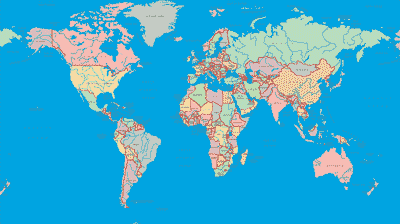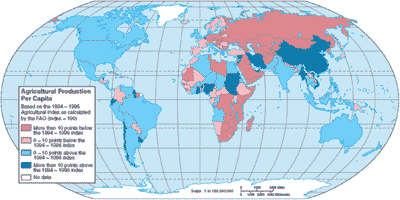All the People in the World
Here's another puzzle that is an example of a Fermi question. This time we ask you to estimate population and land use.
The world population is growing rapidly. At the same time, we are faced with global warming, destruction of rain forests, and other human activities that are reducing the amount of productive land on the planet.
These circumstances generate some intriguing—and vitally important—mathematical/scientific/economic/cultural problems. We pose a few simple ones for this puzzle.
- If the entire land area of the Earth were divided equally among all the inhabitants, approximately how much area would each person get?

Figure 1. A map of the world - If the entire productive land on the planet were divided equally among all the inhabitants, approximately how much area would each person get?
 Source: McGraw-Hill [1]
Source: McGraw-Hill [1]
Figure 2. Worldwide agricultural land use. The pink regions are places where agricultural production per capita has declined since 1994-96. The blue regions show where per capita production has increased. -
How much productive land would be each person’s share in the year 2050 if current population, climate, and economic trends continue?

Figure 3. Visualizing all the people in the world gathered together. - Finally, here’s a little fantasy that’s just fun to think about. If everyone on the Earth were brought together in one place, and given a simple stool to sit on, how much area would it take to hold everyone on Earth? What existing country (or province of a country) would be just about large enough to hold everyone on the planet? How much area would be needed in 2050? What country or region would be large enough to hold everyone at that time?
All the data you’ll need can be readily found on the Internet. You’ll need to make some additional estimates to come up with an answer for part 4.
Background
Fermi questions
This puzzle is the fourth in a series devoted to examples of “Fermi questions ”, named in honor of the Nobel laureate and nuclear physicist Enrico Fermi. Fermi used to give his students problems that involved large numbers, estimates, and approximations. He expected his students to be able to simplify the numbers and do all their calculations on a small piece of paper. They are sometimes called “back of the envelope ” problems. You can find many examples on the Web if you search for “Fermi questions. ”
Fermi questions involve making many assumptions, approximations, and simplifications to try to get a reasonable answer quickly. Your answer doesn ’ t have to be exactly correct — maybe there is no exact answer, because the problem is vague or conditions can vary. A Fermi question does not give you all the information you need; you need to look things up and/or make assumptions.
Global population and land use estimates
There are many sources for information about this, such as national governments, the United Nations, and nongovernmental organizations. You’ll find that there is a reasonable consensus among many sources about expected population growth, while estimates about changes in land mass, land use, and so forth may differ widely among different organizations.
You’ll find all the information at your fingertips if you search the Web for topics such as world population or world land use. Good hunting!
This content has been re-published with permission from SEED. Copyright © 2025 Schlumberger Excellence in Education Development (SEED), Inc.
Course:
- Math [2]
- Math Puzzle [5]
